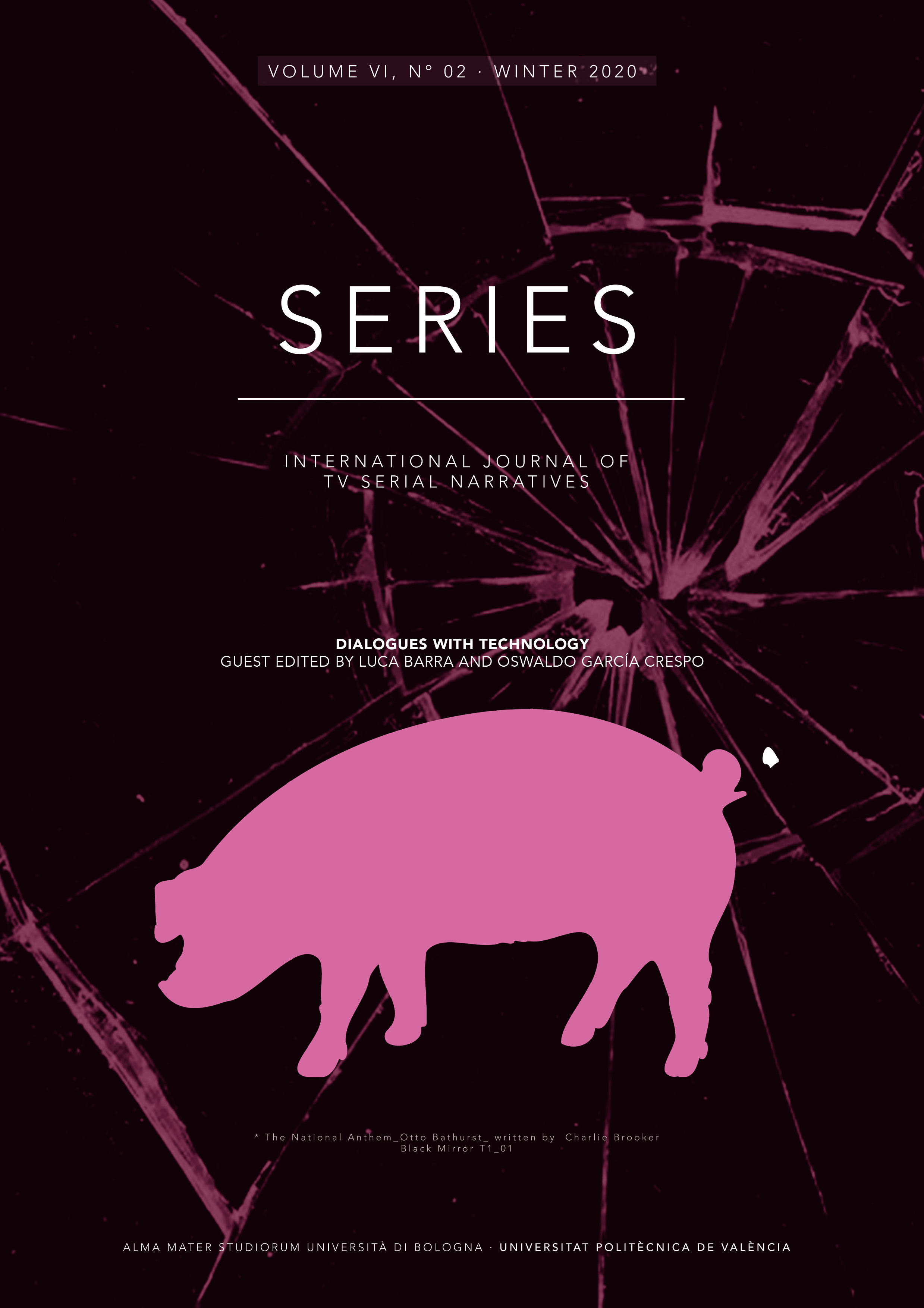Against interactivity. Phenomenological notes on Black Mirror: Bandersnatch
DOI:
https://doi.org/10.6092/issn.2421-454X/11410Keywords:
Interactive cinema, Bandersnatch, Black Mirror, Netflix, Transmedia storytellingAbstract
Interactive cinema is one of the most interesting areas of experimentation with storytelling form. Black Mirror: Bandersnatch (2018), a stand-alone episode of the acclaimed British television series available on Netflix, has restarted the debate around this genre. This article offers a discussion of several critical elements inherent to the experience of viewing Bandersnatch, specifically those related to its interactive, meta-reflexive, and ludic character. The tension between interactive and interpretative cooperation, between actuality and virtuality, between self-reflexivity and self-referentiality, between free choice and control, between co-authorship and authority, and between gaming and gambling, bring out the contradictions of a product characteristic of the current transmedial landscape.
References
Ben-Arie, Udi and Noam Knoeller (2015). “The Holodeck is all Around Us—Interface Dispositifs in Interactive Digital Storytelling”. In Interactive Digital Narrative: History, Theory and Practice, edited by Hartmut Koenitz et al. 51-66. New York: Routledge.
Biocca, Frank (1997). “The Cyborg’s Dilemma: Embodiment in Virtual Environments.” Journal of Computer-Mediated Communication 3(2): 12-26. https://doi.org/10.1111/j.1083-6101.1997.tb00070.x.
Buckland, Warren (ed.) (2009). Puzzle Films: Complex Storytelling in Contemporary Cinema. Oxford: Wiley-Blackwell.
Cardona-Rivera, Rogelio E., Anne Sullivan and R. Michael Young (eds.) (2018). Interactive Storytelling. 12th International Conference on Interactive Digital Storytelling, ICIDS 2019, Proceedings. Cham: Springer.
Cirucci, Angela M. and Barry Vacker (eds.) (2018). Black Mirror and Critical Media Theory. London: Lexington Books.
Conley, Donovan and Benjamin Burroughs (2020). “Bandersnatched: Infrastructure and Acquiescence in Black Mirror.” Critical Studies in Media Communication 37(2): 1-14. http://dx.doi.org/10.1080/15295036.2020.1718173.
D’Aloia, Adriano (2013). “Cinema d’azzardo.” Fata Morgana 19: 137-148.
Daly, Kristen (2008). Cinema 3.0: How Digital and Computer Technologies are Changing Cinema. Ann Arbor, MI: ProQuest LLC.
Daly, Kristen (2010). “Cinema 3.0: The Interactive-Image.” Cinema Journal 50(1): 81-98.
Eco, Umberto (1979). The Role of the Reader: Explorations in the Semiotics of Texts. Bloomington: Indiana University Press.
Elnahla, Nada (2019). “Black Mirror: Bandersnatch and How Netflix Manipulates Us, the New Gods.” Consumption Markets & Culture: 1-6. https://doi.org/10.1080/10253866.2019.1653288.
Elsaesser, Thomas (2009). “The Mind Game Film.” In Puzzle Films: Complex Storytelling in Contemporary Cinema, edited by Warren Buckland, 13-41. Oxford: Wiley-Blackwell.
Elsaesser, Thomas (2014). “Philip K. Dick, the mind-game film, and retroactive causality.” In Hollywood Puzzle Films, edited by Warren Buckland, 143-64. London: Routledge.
Everett, Anna (2004). “Click This: From Analog Dreams to Digital Realities.” Cinema Journal 43(3): 93-98.
Galloway, Alexander R. (2004). Gaming: Essays on Algorithmic Culture. Minneapolis: University of Minnesota Press.
Gibson, Margaret and Clarissa Carden (eds.) (2020). The Moral Uncanny in Black Mirror. Cham: Palgrave-MacMillan.
Hales, Chris (2015). “Interactive Cinema in the Digital Age.” In Interactive Digital Narrative: History, Theory and Practice, edited by Hartmut Koenitz et al. 36-50. New York: Routledge.
Hebben, Kim (2019). “Television’s Figuration(s): Playful Media Practices Between Autonomy and Control.” Media in Transition 10 (MiT10): Democracy and Digital Media. Massachusetts Institute of Technology (May 17th, 2019). https://www.academia.edu/41287134/Televisions_Figuration_s_Playful_Media_Practices_Between_Autonomy_and_Control (last accessed 09-07-20).
Jenkins, Henry (2006). Convergence Culture: Where Old and New Media Collide. New York: New York University Press.
Kinder, Marsha (2002). “Narrative Equivocations between Movies and Games.” In The New Media Book, edited by Dan Harries, 119-32. London: BFI Publishing.
Klinger, Barbara (1989). “Digressions at the Cinema: Reception and Mass Culture.” Cinema Journal 28(4): 3-19. https://doi.org/ 10.2307/1225392.
Koenitz, Hartmut, Gabriele Ferri, Mads Haahr, Diğdem Sezen and Tonguç İbrahim Sezen (eds.) (2015). Interactive Digital Narrative: History, Theory and Practice. New York: Routledge.
Laraway, David (2020). Borges and Black Mirror. Cham: Palgrave-MacMillan.
Larsen, Lasse J. (2019). “Play and Gameful Movies: The Ludification of Modern Cinema.” Games and Culture 14(5): 455-77. https://doi.org/10.1177/1555412017700601.
Lunenfeld, Peter (2002). “The Myths of Interactive Cinema.” In The New Media Book, edited by D. Harries, 144-54. London: BFI Publishing.
Manovich, Lev (2001). The Language of New Media. Cambridge, MA: MIT Press.
McSweeney, Terence and Stuart Joy (eds.) (2019). Through the Black Mirror: Deconstructing the Side Effects of the Digital Age. Cham: Palgrave-MacMillan.
Metz, Christian (1982). The Imaginary Signifier: Psychoanalysis and the Cinema. Bloomington: Indiana University Press.
Montani, Pietro (2014). Tecnologie della sensibilità. Estetica e immaginazione interattiva. Milano: Raffaello Cortina.
Montani, Pietro (2019), “Elogio in 10 punti di Bandersnatch”, Fata Morgana Web, January 14, https://www.fatamorganaweb.unical.it/index.php/2019/01/14/bandersnatch-black-mirror/ (last accessed 09-07-20).
Salen, Katie and Eric Zimmerman (2004). Rules of Play: Game Design Fundamentals. Cambridge, MA: MIT Press.
Shaul, Nitzan Ben (2008). Hyper-Narrative Interactive Cinema Problems and Solutions. Amsterdam: Rodopi.
Shaviro, Steven (2010). “Post-cinematic Affect”. Washington, D.C.: Zero Books.
Stoldt, Ruan (2019). “The Gamification of Television? Bandersnatch, Video Games, and Human-Machine Interaction.” Flow Journal, November 4, https://www.flowjournal.org/2019/11/gamification-of-television/ (last accessed 06-10-20).
Zecca, Federico (2015). “La ludicizzazione del testo filmico, appunti sparsi.” In L’immagine videoludica, edited by Antonio Catolfi and Federico Giordano, 105-17. Napoli: Ipermedium.
TV series and other media cited
Black Mirror (Channel 4, 2011-2014; Netflix, 2016-)
Black Mirror: Bandersnatch (David Slade, 2018)
Ready Player One (Steven Spielberg, 2018)
Sugarcane Island (Edward Packard, 1976)
Downloads
Published
How to Cite
Issue
Section
License
Copyright (c) 2020 Adriano D'Aloia

This work is licensed under a Creative Commons Attribution 3.0 Unported License.




